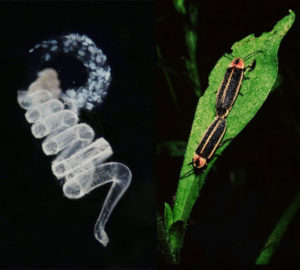
Fireflies are omnivores, about 1 inch in size and live about 2 months. They are actually beetles, nocturnal members of the family Lampyridae. Most are winged, which distinguishes them from glowworms of the same family. There are about 2,000 firefly species that live in a variety of warm environments, as well as temperate regions. Fireflies love moisture and often live in humid regions of Asia and the Americas. In drier areas, they are found around damp areas that retain moisture.
People don’t know how the insects produce their glow. They have dedicated light organs located under their abdomens. Fireflies take in oxygen and combine it with a substance called luciferin to produce light with almost no heat. Fireflies flash in patterns unique to each species. They are optical signals that help fireflies. Firefly light may also serve as a defense mechanism that flashes a clear warning of the insect’s unappetizing taste. The fact that even larvae are luminescent lends support to this theory.
Females deposit eggs in the ground, where larvae develop to adulthood. Underground larvae feed on worms and slugs by injecting them with a numbing fluid. Adults eschew such prey and typically feed on nectar or pollen, though some adults do not eat at all. Fireflies tend to be brown, soft bodied, often with the elytra more leathery than in other beetles. Some females are similar in appearance to males. Larviform females are found in many other firefly species. Females can often be distinguished from the larvae only by their compound eyes.
The most commonly known fireflies are nocturnal. There are numerous species that are diurnal, are mostly non-luminescent. A few days after mating, a female lays fertilized eggs on or just below the surface of the ground. Eggs hatch 3-4 weeks later and the larvae feed until the end of summer. Larvae are commonly called glowworms, not to be confused with the distinct beetle family Phengodidae or fly genus Arachnocampa. Lampyrid larvae have simple eyes. The term glowworm is also used for both adults and larvae of species such as Lampyris noctiluca, the common European glowworm, in which only the non-flying adult females glow brightly and the flying males glow only weakly and intermittently.
Fireflies overwinter during the larval stage, some species for several years. Some do this by burrowing underground or under the bark of trees. They emerge in the spring, eat for several weeks, pupate for 1 to 2.5 weeks, and emerge as adults. The larvae of most species are specialized predators and feed on other larvae, terrestrial snails, and slugs. Some are so specialized that they have grooved mandibles which deliver digestive fluids directly to their prey. Adult diet varies. Some are predatory, while others feed on plant pollen or nectar. Most fireflies are distasteful and sometimes poisonous to vertebrate predators due in part to a group of steroid pyrones (LGBs)
Light production in fireflies is due to a type of chemical reaction called bioluminescence. This process occurs in specialized light-emitting organs, usually on a firefly’s lower abdomen. The enzyme luciferase acts on luciferin, in the presence of magnesium ions, ATP (adenosene triphosphate), and oxygen to produce light. Genes coding for these substances have been inserted into many different organisms (see Luciferase – Applications). Luciferase is used in forensics, and the enzyme has medical uses. All fireflies glow as larvae. Bioluminescence serves a different function in lampyrid larvae than it does in adults. It appears to be a warning signal to predators, since many firefly larvae contain chemicals that are distasteful or toxic. It is thought that light in adults beetles was originally used for similar warning purposes, but evolved for use in mate selection. Now fireflies are a classic example of an organism that uses bioluminescence for sexual selection. They have evolved a variety of ways to communicate with mates in courtships. From steady glows, flashing, as well as the use of chemical signals unrelated to photic systems.
Some species, especially lightning bugs of the genera Photinus, Photuris and Pyractomena, are distinguished by the unique courtship flash patterns emitted by flying males in search of females. Females of the Photinus genus generally do not fly, but do give a flash response to males of their own species. Firefly larva Tropical fireflies, particularly in Southeast Asia, routinely synchronize their flashes among large groups, an example of biological synchronicity. In some fields, this phenomenon is explained as phase synchronization and spontaneous order. At night along river banks in the Malaysian jungles (most notably found near Kuala Selangor), fireflies (“kelip-kelip” in the Malay language or Bahasa Malaysia) synchronize their light emissions precisely. Current hypotheses about the causes of this behavior involve diet, social interaction, and altitude. In the United States, one of the most famous sightings of fireflies blinking in unison occurs annually near Elkmont, Tennessee in the Great Smoky Mountains during the first weeks of June. Congaree National Park in South Carolina is another host to this phenomenon.
Female Photuris fireflies are known for mimicking the mating flashes of other “lightning bugs” for the sole purpose of predation. Target males are attracted to what appears to be a suitable mate, and are then eaten. For this reason the Photuris species are sometimes referred to as “femme fatale fireflies.” Many fireflies do not produce light. Usually these species are diurnal, or day-flying, such as those in the genus Ellychnia. A few diurnal fireflies that primarily inhabit shadowy places, such as beneath tall plants or trees, are luminescent. One such genus is Lucidota. These fireflies use pheromones to signal Males coming from downwind arrived at females first, male arrival was correlated with downwind direction, this is most likely into which the pheromone plume is dispersed. It mates. This is supported by the fact that some basal groups do not show bioluminescence, and rather use chemical signaling. Looking at pheromones in Phosphaenus Hemipterus, P. Hemipterus has photic organs, yet is a diurnal firefly and displays large antenna and small eyes. These traits strongly suggest that pheromones are used for sexual selection, while photic organs are used for warning signals. It was also found that males were able to find females without the use of visuals, the sides of the petri dishes were covered with black tape. This, along with the facts that females don’t light up at night and males are diurnal, points to the conclusion that sexual communication in P. Hemipterus is entirely based on pheromones.
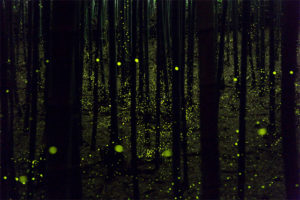
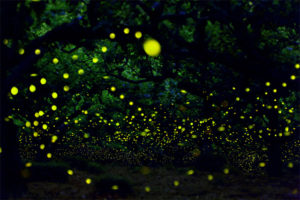
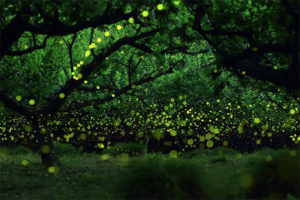
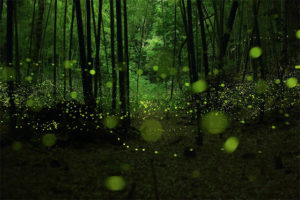
Glow worm cave in New Zealand

